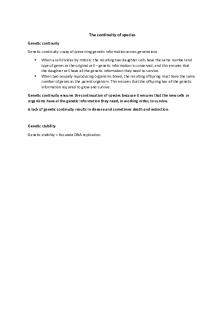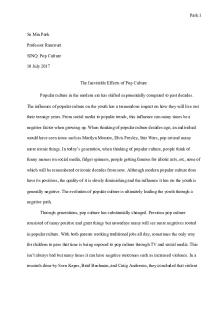Halucin. Paper - The effects of Hallucinogen drugs PDF

| Title | Halucin. Paper - The effects of Hallucinogen drugs |
|---|---|
| Author | Piper Ramsey |
| Course | Business Administration |
| Institution | St. Mary's College |
| Pages | 3 |
| File Size | 50.7 KB |
| File Type | |
| Total Downloads | 50 |
| Total Views | 162 |
Summary
The effects of Hallucinogen drugs ...
Description
Hallucinogens are a diverse group of drugs that induce visual and auditory hallucinations and cause changes in perception, thought, and mood. These drugs can be naturally occurring, such as psilocybin mushrooms and peyote cactus (mescaline), or they can be chemically made, such as phencyclidine (PCP), ketamine (Special K), lysergic acid diethylamide (LSD), and MDMA (Molly or ecstasy). They are commonly split into two categories: Classic Hallucinogens which causes profound distortions in a person’s perceptions of reality and Dissociative Drugs which distort a user's perceptions of sight and sound and create feelings of detachment from their environment and self. Although dissociative drugs are mind-altering, they are not technically hallucinations. Classic Hallucinogens: LSD is a schedule I drug. It is a clear and odorless material made from lysergic acid; a compound derived from a rye fungus. It usually comes in liquid form that can be soaked onto tiny paper squares called “blotters” and put onto the tongue or dropped onto sugar cubes. It first appeared in the U.S. in the 1940’s when it was used to study schizophrenia due to its potent psychotropic effects. The uses of LSD quickly spread to include many other medical and clandestine uses. In the 1950’s the CIA conducted human experiments with LSD called Project MK-Ultra. They tried using it as an interrogation tool used to produce anxiety or terror and also as a mind control agent. Unfortunately, many of these studies were conducted without the consent of the participant and LSD was deemed too unpredictable to use in the field. It made a comeback in the 1960’s as a popular hippy drug.
Psilocybin is a schedule I drug. It is from certain types of mushrooms found in tropical and subtropical parts of South America, Mexico, and the U.S. It is usually dried and mixed with food or brewed into a tea. In the past, it was used during religious ceremonies by indigenous cultures as a way to enhance their spiritual experience by deepening their spiritual connection to their deity. Mescaline is a schedule I drug. It is from the North American peyote cactus. The hallucinatory effect is very similar to psilocybin mushrooms. The dried bitter fleshy tops of the cactus are dried and eaten or grinded into a powder and put in capsules to avoid having to taste it. Native Americans have used it in their ritual practices for centuries. Dissociative Drugs: PCP Phencyclidine is a schedule II drug. It was developed by a pharmaceutical company in the late 1950s as a potential anesthetic for surgery. Its medical use was short lived due to its many neurotoxic adverse side effects. It is usually found in powder form and is most often snorted or smoked. Ketamine is a schedule III drug. It has been available by prescription in the U.S. since the 1970s as an anesthesia medicine for human and veterinary uses. It is manufactured as an injectable liquid, but on the streets, it's evaporated to form a powder that is snorted or made into tablets. MDMA is a schedule I drug. It is popular for giving the users the high of amphetamines and the effects of hallucinogens hence the name ecstasy. It was also the object of study for the CIA’s MK-Ultra program before they experimented with LSD. On the streets, it can be taken as a
pill, capsule, or tablet. The pills come in different colors, or have images of cartoons or words printed on them.
Gross, Terry "The CIA's Secret Quest For Mind Control: Torture, LSD And A 'Poisoner In Chief'" 9, Sept. 2019 https://www.npr.org/2019/09/09/758989641/the-cias-secret-quest-for-mindcontrol-torture-lsd-and-a-poisoner-in-chief NIDA. "Hallucinogens and Dissociative Drugs." National Institute on Drug Abuse, 1 Feb. 2015 https://www.drugabuse.gov/publications/research-reports/hallucinogens-dissociativedrugs/what-are-dissociative-drugs Blanco-Suarez, Elena “The Art of Brainwashing”, 21 March, 2018 https://www.psychologytoday.com/us/blog/brain-chemistry/201803/the-art-brainwashing Meyer, Elisa “How Psychedelics and Other Drugs are Used in Religious Rituals” 2 Jan. 2017 https://www.worldreligionnews.com/religion-news/psychedelics-drugs-used-religious-rituals Tareg Bey, Anar Patel “Phencyclidine Intoxication and Adverse Effects: A Clinical and Pharmacological Review of an Illicit Drug”. 8 Feb. 2007https://www.ncbi.nlm.nih.gov/pmc/articles/PMC2859735/...
Similar Free PDFs

THE EFFECTS OF CORRUPTION
- 5 Pages

Effects of the Sugar REvolution
- 4 Pages

Position paper war on drugs
- 6 Pages

Chapter 5 - The Actions of Drugs
- 6 Pages

Evaluation of crude drugs
- 7 Pages

The Negative Effects of Video Games
- 16 Pages
Popular Institutions
- Tinajero National High School - Annex
- Politeknik Caltex Riau
- Yokohama City University
- SGT University
- University of Al-Qadisiyah
- Divine Word College of Vigan
- Techniek College Rotterdam
- Universidade de Santiago
- Universiti Teknologi MARA Cawangan Johor Kampus Pasir Gudang
- Poltekkes Kemenkes Yogyakarta
- Baguio City National High School
- Colegio san marcos
- preparatoria uno
- Centro de Bachillerato Tecnológico Industrial y de Servicios No. 107
- Dalian Maritime University
- Quang Trung Secondary School
- Colegio Tecnológico en Informática
- Corporación Regional de Educación Superior
- Grupo CEDVA
- Dar Al Uloom University
- Centro de Estudios Preuniversitarios de la Universidad Nacional de Ingeniería
- 上智大学
- Aakash International School, Nuna Majara
- San Felipe Neri Catholic School
- Kang Chiao International School - New Taipei City
- Misamis Occidental National High School
- Institución Educativa Escuela Normal Juan Ladrilleros
- Kolehiyo ng Pantukan
- Batanes State College
- Instituto Continental
- Sekolah Menengah Kejuruan Kesehatan Kaltara (Tarakan)
- Colegio de La Inmaculada Concepcion - Cebu









